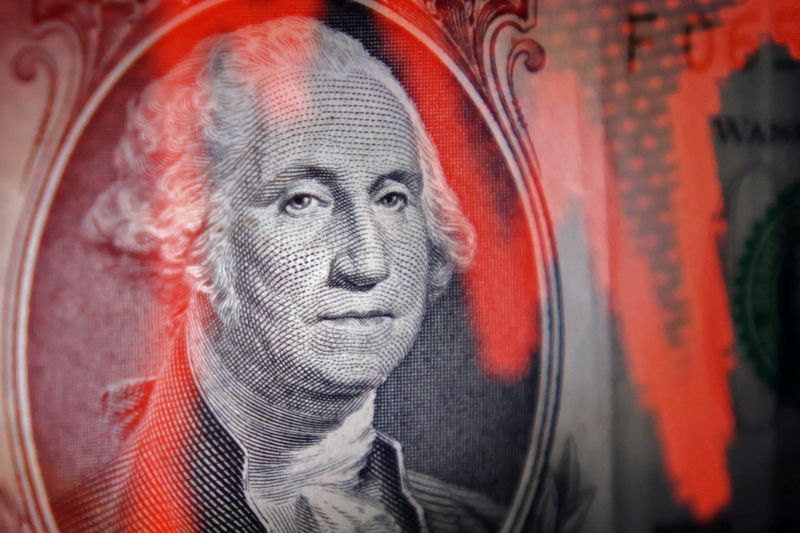
By Kevin Buckland
TOKYO (Reuters) -The U.S. dollar hovered below a one-week high on Thursday and Asian stock markets were broadly mixed as investors braced for three days of potentially market-moving news from the Federal Reserve's annual symposium in Jackson Hole.
Central bankers from around the world will attend the event, which begins later in the day, although the key focus will be Fed Chair Jerome Powell's speech on Friday as traders look for clues on the chances of a September rate cut.
Japan's Nikkei drooped 0.6% in the morning session, retreating further from the record peak reached on Tuesday.
Despite a tech-led selloff on Wall Street overnight, Japanese chip stocks were a mixed bag, with Advantest up 3% while Tokyo Electron dropped 2%.
South Korea's KOSPI bounced 0.9% after dipping to a six-week low on Wednesday. Australia's benchmark gained 0.6% and renewed an all-time high.
Mainland Chinese blue chips gained 0.5%, although Hong Kong's Hang Seng was largely flat.
U.S. stock futures pointed lower, with Nasdaq futures sagging 0.2% and S&P 500 futures easing 0.1%. Overnight, the Nasdaq Composite slid 0.7% and the S&P 500 cash index slipped 0.2%. [.N]
"There remains a bearish skew for equities at the moment," said Kyle Rodda, an analyst at Capital.com.
"Equity prices are beginning to reflect the risk of disappointment at Jackson Hole, with doubts circulating about whether the Fed will pivot as aggressively in the dovish direction implied by rates markets - or even pivot at all."
Traders currently lay odds of about 80% for a quarter-point Fed rate cut on September 17, and price in a total of 52 basis points of easing over the rest of the year. This time on Wednesday, the odds for a cut next month stood at 84%.
Fed Chair Powell has said he is reluctant to cut rates because of expected tariff-driven price pressures this summer.
Minutes out overnight from the Fed's July gathering, when policymakers voted to keep rates steady, suggested that Fed Vice Chair for Supervision Michelle Bowman and Governor Christopher Waller were alone in pushing for a rate cut at the meeting.
Traders ramped up bets for a September cut following a surprisingly weak payrolls report at the start of this month, and were further encouraged after consumer price data showed limited upward pressure from tariffs.
However, a hotter-than-expected producer price reading last week complicated the policy picture.
Traders aren't looking at macroeconomic data as the only potential influencer of monetary policy direction, with President Donald Trump again exerting pressure on the central bank overnight.
After continuing his attacks on Powell earlier in the week for refraining from cutting rates, Trump on Wednesday targeted Fed Governor Lisa Cook, demanding she resign amid allegations of wrongdoing connected to mortgages on properties she owns in Georgia and Michigan.
Cook said she had "no intention of being bullied to step down".
Trump's push for more control over the Fed unnerved investors earlier in the year, sending the dollar tumbling.
The currency has largely taken the latest developments in stride though, and the dollar index was steady at 98.252 on Thursday, after grinding to the highest since August 12 at 98.441 a day earlier.
"The broader implication is rising tensions between the Fed and the U.S. administration," said Rodrigo Catril, a strategist at National Australia Bank.
"Trump's push to confirm Stephen Miran could add another vote for cuts in September, and if he was to successfully remove Cook, the Fed Board could end up with four members out of seven supporting his lower rates call."
Trump nominated Council of Economic Advisers Chair Miran as a Fed governor earlier this month, following the surprise resignation of Adriana Kugler.
U.S. 10-year Treasury yields were steady at 4.2965% in the latest session.
Japanese government bond yields edged higher though, with the 20-year yield advancing to 2.655% for the first time since late 1999. Among other things, investors are wary of increased fiscal spending amid growing pressure for the Japanese prime minister to step down.
The dollar traded little changed at 147.41 yen.
The euro and sterling were flat at $1.1647 and $1.3458, respectively.
Bitcoin continued to claw its way back from a 2-1/2-week low reached Wednesday at $112,386.93, edging up to around $114,690.
Gold eased slightly to around $3,342 per ounce.
Oil prices edged higher as larger-than-expected declines in crude oil and fuel inventories in the U.S. supported expectations for steady demand.
Brent crude futures were up 0.5% to $67.19 a barrel, after gaining 1.6% in the previous session. U.S. West Texas Intermediate (WTI) crude futures rose 0.6% to $63.10, after climbing 1.4% on Wednesday. [O/R]
(Reporting by Kevin Buckland)

 Reuters US Business
Reuters US Business
 America News
America News Reuters US Politics
Reuters US Politics Reuters US Economy
Reuters US Economy The Motley Fool
The Motley Fool Raw Story
Raw Story The Daily Beast
The Daily Beast Washington Examiner
Washington Examiner  5 On Your Side Sports
5 On Your Side Sports The List
The List